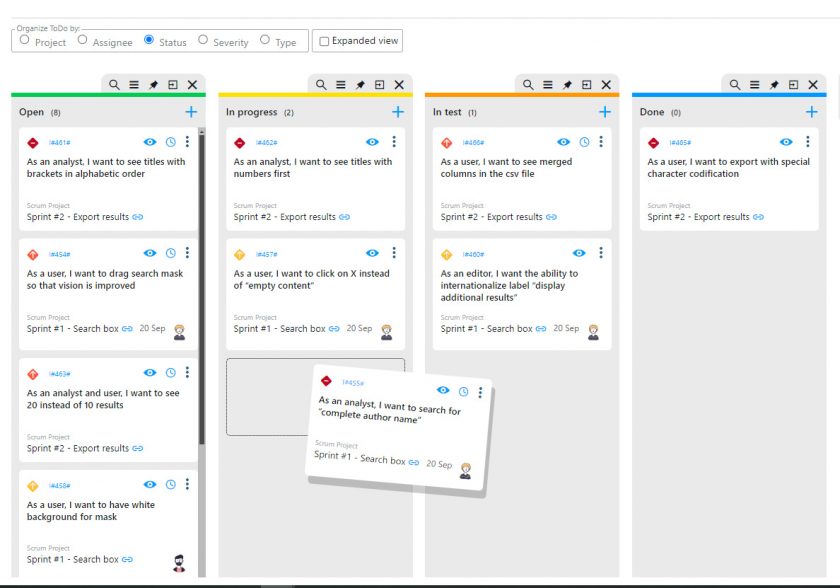Kanban vs. Scrum are two widely used project management approaches for organizing and managing work.
These two methodologies each have their distinct principles and practices and are best suited for different scenarios.
In this article, we will examine the key differences between Kanban and Scrum and when to use one or the other method.
CONTENT
Kanban method, what is it?
Kanban was born in the automotive industry, but its principles are now broadly used in other environments as well.
It is a visual project management method that tracks activities and minimizes project inefficiencies.
The core of the Kanban method is its distinctive Kanban board, on which project phases are divided into columns and tasks are written on cards that progress from one column to the next until they are completed.
The major benefit of using Kanban is improved transparency, which is achieved through a clear display of the tasks that need to be completed and their status.
Scrum method, what is it?
Scrum is an Agile methodology specifically designed for complex projects where it is often necessary to adapt to change.
This system is based on short development cycles called sprints, typically lasting from one to four weeks.
A Scrum team is usually self-organized, small, and includes a Scrum Master and a product owner.
As is typical in Agile frameworks, Scrum employs an iterative approach to project completion: instead of delivering the result all at once, the team completes and delivers tasks in several phases.
This makes it easy to adapt to changes and evolving priorities.
Kanban vs Scrum: key differences
Entrambe le metodologie, Kanban e Scrum, si basano su principi agili, ma sono Although both methodologies, Kanban and Scrum, are based on agile principles, they are applied differently for project and workflow management. Let’s explore in detail their main differences in structure, workflow, scope, roles, and metrics.
Structure
Scrum focuses mainly on iterations of tasks or small fixed time frames, called sprints. These, as earlier mentioned, last from one to four weeks and act as time intervals for increments of work.
On the other hand, the Kanban methodology does not involve sprints. Instead of focusing on task duration and predictability, in Kanban, one is more interested in task execution and cycle time reduction.

Workflow and visualization
Scrum uses a scrum board to keep track of tasks assigned to the team during a sprint.
Work components are presented in columns representing different phases, such as “To Do,” “In Progress,” and “Completed.” Yet, the number of tasks per sprint is determined at the beginning, and the team focuses on executing them during the established cycle.
Kanban, on the other hand, is more flexible. The workflow is displayed on a kanban board with similar columns, but the number of tasks per iteration is not limited.
Kanban implements the concept of Work-in-Progress (WIP) limits, which limit the number of activities that can be going on at the same time in each phase. This helps prevent work overload and keeps the flow continuous.
In short:
- Scrum: Board focused on sprints, with activities assigned to each iteration.
- Kanban: Flexible and seamless board, with limits on work in progress to optimize flow.
Scope
In the Scrum methodology, the team estimates how long it takes to build a feature to completion, using fixed sprints to gauge progress. The purpose of measuring velocity is not to assess productivity but to help the team properly plan the time needed to deliver a quality result.
Kanban’s main goal is to ensure a seamless flow with minimal bottlenecks. Unlike the Scrum method, Kanban is more suitable for projects without a backlog.
Roles
Scrum is based on three pre-defined roles:
- Product owner: In charge of initial planning, prioritization and communication;
- Scrum master: In charge of overseeing the planning and reviews of sprint and retrospective meetings;
- Team members: In charge of performing the work necessary for the completion of each sprint.
Kanban, on the other hand, has no specific roles or formal hierarchies. Any team member can be in charge of the work being done, and tasks can be assigned flexibly. This makes Kanban especially suitable for teams with a fluid structure and less dependent on defined roles.
In short:
- Scrum: Three well-defined roles (Product Owner, Scrum Master, Team Member).
- Kanban: No formal role, more flexible work management.
Performance measurement
Scrum makes use of several metrics to gauge team performance:
- Velocity: Team speed is the amount of work completed during a sprint.
- Burndown Chart: A chart showing how much work remains to be completed within a sprint.
Kanban focuses on other metrics:
- Cycle Time: The time it takes for a task to go from “Start” to “Completion.”
- Lead Time: The total time from a request’s receipt in the system until its completion.
- Throughput: The number of activities completed in a given period.
Kanban metrics are more flexible and suitable for monitoring ongoing workflow, while Scrum focuses on productivity within iterative cycles.
Kanban vs Scrum: how to choose the best approach
Between Kanban and Scrum, there is no best approach or definition.
The most fitting methodology is based on the specific objectives, corporate culture, team maturity, technical competence, and other factors.
Some key considerations for evaluating the best approach are:
- Learn about available methodologies: Many teams adopt the wrong approach because they do not know the alternatives.
- Asking for external help: Sometimes, it is difficult to objectively assess one’s own knowledge and performance. Getting input and feedback from external people can clarify one’s goals.
- Evaluate the maturity of the process: Is the team still increasing its technical expertise? Then, an approach that provides structure and consistency might be the best go-to strategy. Once the team has developed its proficiency with the technology, a framework providing more fluidity and flexibility may be worth considering. Alternatively, some teams simply prefer to have more structure in their process, whether they need it or not. Talking to team members, observing how employees work, and listening to what they say may be the key to choosing the best methodology.
Generally speaking, the Kanban methodology can adapt to existing processes.
If you don’t want to revamp your whole work process but want to reap the benefits of an Agile process, Kanban may be a good place to start.
Scrum has generally been associated with higher productivity, faster delivery, lower costs, and higher quality. Many project managers also consider Scrum to be an effective approach for managing complex projects or projects that might see frequent changes, such as those in the technology field.
…What about Scrumban?
Scrumban refers to an approach in which the team uses elements of both Scrum and Kanban to improve performance.
In the Agile framework, Scrum techniques are often already employed, such as defining overall work through sprints and managing the Kanban concept regarding limiting work in progress.
A project management software for Kanban vs Scrum vs Scrumban
Often, the type of software implemented in the enterprise drives the choice of framework, but this should not be the case.
Twproject is a flexible project management solution designed to fit different work management methodologies. It is ideal for teams using Kanban, Scrum, Scrumban, or a combination of approaches.
Thanks to its flexibility, it offers customizable tools and features that allow teams to tailor the software to their needs while maintaining control over complex projects and dynamic workflows.
One of Twproject‘s major plus points is, as we have already discussed, its ability to adapt to different needs, regardless of the methodology used.
Some of the key features that make it particularly versatile include:
- Board customization: Twproject allows teams to customize their Kanban boards or Scrum boards as needed. Columns can be renamed and adjusted to reflect team or project-specific work steps.
- Detailed reporting: It offers various customizable reports to track team performance. Reports can be set up to provide details on specific metrics, such as cycle time or team speed, and can be exported for sharing with external stakeholders.
Twproject not only helps manage workflow but also promotes collaboration among team members. Its collaborative features include:
- Resource management and task allocation: Project managers can easily assign tasks to team members, monitor progress, and balance workload among team members.
- Real-time communication: Twproject offers features designed to streamline communication among team members. Comments, status updates, and notes can be added directly to tasks, keeping the team informed and aligned on goals and progress.
- Time tracking: This software helps team members track time spent on each task, providing managers with precious data to improve planning and resource allocation in future projects.
Whether a Kanban-oriented team aims to optimize the continuous flow of work, a Scrum team working with sprints and fixed iterations, or a Scrumban team seeking flexibility and control, Twproject offers all the features needed to ensure project success.



